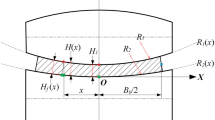Abstract
We introduce a method for designing manufacturing shapes for the structural parts of a ship that considers the weld-induced deformation. In this study, the design shape of a bracket was counter-deformed using a purely geometric method rather than a thermo-elastic method. The deformation quantities were estimated based on data captured in the field, and a manufacturing design shape was obtained by counter-deforming an original design shape using the proposed geometric deformation method. The proposed method was implemented and tested in a shipyard.















Similar content being viewed by others
References
Jang KB, Cho SM (2003) The analysis of welding deformation in arc-spot welded structure (II)—displacement monitoring and deformation analysis. J KWS 21(4):450–456
Park JG, Cho SM, Heo HY, Yi MS, Jan TW, Kim YG (2013) Development of automatic re-design system based on shipbuilding CAD system. In: The Proceedings of the Society of CAD/CAM Conference, Pyeongchang. pp 489-491
Jang CD, Ko DE, Ha YS (2008) Simulation of plate deformation due to triangle heating using inherent strain method. J Soc Naval Archit Korea 45(6):703–709
Park JK, Ha YS, Yang JH (2008) Method for designing of automatic curved built-up by using 1 dimensional equivalent thermal expansion coefficients, Samsung Heavy Industry, Patent 10-0903904-0000
Wang J, Rashed S, Murakawa H (2011) Investigation of buckling deformation of thin plate welded structures. In: Proceedings of International Society of Ocean and Polar Engineering, Hawaii, USA, pp 125–131
Liu L, Liang G, Liu Y, Zhan Z (2003) Numerical simulation of welding deformations for hull superstructure steel based on the finite element analysis. J Mater Sci Technol 19(1):212–214
Murakawa H, Deng D, Rashed S, Sato S (2009) Prediction of distortion produced on welded structures during assembly using inherent deformation and interface element. Trans JWRI 38(2):63–69
Deng D, Murakawa H, Ma N (2012) Predicting welding deformation in thin plate panel structure by means of inherent strain and interface element. Sci Technol Weld Join 17(1):13–21
Tsai CL, Park SC, Cheng WT (1999) Welding distortion of a thin-plate panel structure. Weld J 78(5):156–164
Wei J, Gong-liang L (2011) Forecast for butt welding deformation of the medium thickness plate based on genetic neural network. In: The Proceedings of 2011 International Conference on Electric Technology and Civil Engineering (ICETCE), Lushan, China
Celniker G, Gossard D (1991) Deformable curve and surface finite elements for free-form shape design. Comput Graph 25(4):257–266
Müller M, Heidelberger B, Teschner M, Gross M (2005) Meshless deformations based on shape matching. ACM Trans Graph 24(3):471–478
Liang W, Deng D, Sone S, Murakawa H (2005) Prediction of welding distortion by elastic finite element analysis using inherent deformation estimated through inverse analysis. Weld World 49(11/12):30–39
Igarashi T, Moscovich T, Hughes JF (2005) As-rigid-as-possible shape manipulation. ACM Trans Graph 24(3):1134–1141
Weng Y, Xu W, Wu Y, Zhou K, Guo B (2006) 2D Shape deformation using nonlinear least squares optimization. Vis Comput 22(9):653–660
Press WH, Teukolsky SA, Vetterling WT, Flannery BP (2007) Numerical recipes: the art of scientific computing, 3rd edn. Cambridge University Press, New York
Shewchuk JR (1996) Triangle: engineering a 2D quality mesh generator and Delaunay triangulator, applied computational geometry: towards geometric engineering, vol. 1148 of Lecture Notes in Computer Science. Springer, Berlin, pp 203–222
Triangle (2013). http://www.cs.cmu.edu/~quake/triangle.html. Accessed in 2013
Cha M, Yang J, Han S (2008) An interactive data-driven driving simulator using motion blending. Comput Ind 59(5):520–531
Lee J, Chai J, Reitsma P, Hodgins JK, Pollard N (2002) Interactive control of avatars animated with human motion data. In: The Proceedings of the SIGGRAPH2002, San Antonio, USA. pp 491–500
Tang K, Wang CCL (2005) Modeling developable folds on a strip. J Comput Inf Sci Eng 5(1):35–47
Cao X, Jahazi M, Immarigeon JP, Wallace W (2006) A review of laser welding techniques for magnesium alloys. J Mater Process Technol 171(2):188–204
Messler RW Jr, Jou M (1996) Review of control systems for resistance spot welding: past and current practices and emerging trends. Sci Technol Weld Join 1(1):1–9
Uday MB, Ahmad Fauzi MN, Zuhailawati H, Ismail AB (2010) Advances in friction welding process: a review. Sci Technol Weld Join 15(7):534–558
Rai R, De A, Bhadeshia HKDH, DebRoy T (2011) Review: friction stir welding tools. Sci Technol Weld Join 16(4):325–342
Acknowledgement
This research was supported by the Industrial Core Technology Development Program (Project ID: 10048341) funded by the Ministry of Trade, Industry and Energy of the Korean government. The authors gratefully acknowledge their support.
Author information
Authors and Affiliations
Corresponding author
About this article
Cite this article
Cheon, SU., Kim, B.C. & Mun, D. Counter-deformed design of ship structural parts using geometric shape deformation based on welding distortion estimation. J Mar Sci Technol 20, 442–453 (2015). https://doi.org/10.1007/s00773-014-0296-8
Received:
Accepted:
Published:
Issue Date:
DOI: https://doi.org/10.1007/s00773-014-0296-8




